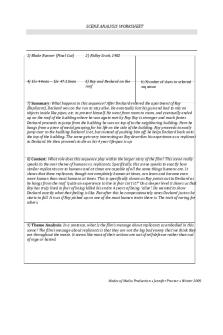Film Scene Analysis Twelve O’clock High PDF

| Title | Film Scene Analysis Twelve O’clock High |
|---|---|
| Author | andy iason |
| Course | Organizational Behaviour |
| Institution | Ryerson University |
| Pages | 2 |
| File Size | 45.4 KB |
| File Type | |
| Total Downloads | 41 |
| Total Views | 420 |
Summary
Instructor Oxana SvergunOrganizational BehaviourMarch 19, 2021Analysis Skill BuilderFilm Scene Analysis: Twelve O’clock HighQ1. In the film, Twelve O’clock High, General Pritchard feels that the failures are caused due to a lack of leadership by Keith Davenport. Keith Davenport is too attached and s...
Description
Instructor Oxana Svergun Organizational Behaviour March 19, 2021
Analysis Skill Builder
Film Scene Analysis: Twelve O’clock High Q1. In the film, Twelve O’clock High, General Pritchard feels that the failures are caused due to a lack of leadership by Keith Davenport. Keith Davenport is too attached and so close to his unit that he feels the need to back them up for their mistakes after the German forces' attacks. One example, Keith Davenport was advised to make his pilots fly at low heights, hoping to turn things, but he felt his men's lives would be a risk. Long story short, Pritchard tells Keith Davenport to have the navigator pilot replaced with another pilot, but Keith denies it, and instead, he is relieved of his duties. A different group commander takes over the 918th group.
Q2. Keith Davenport is quite tricky to describe, but Keith was highly motivated by maintaining close relationships with his fellow crewmates. He also takes care and concern for people on his crew, even if it means it back one other for their mistakes. At the beginning of the scene, the team was exhausted after a chaotic mission followed by casualties of crew members. During the debriefing, a pilot was questioned about the incident that caused such a catastrophe. Near the end of the scene, Pritchard noted a further investigation from 3 deaths and 11 wounded. A missed checkpoint was revealed, and they had flown off course, which led to this incident. Keith Davenport took full accountability for actions that were made by the young navigator which was under his command, as advised him that he had nothing to worry about as he walked out. After General Pritchard suggested having him replaced, Keith Davenport denied it, which relieved him. Keith Davenport's primary leadership showed a focus on his crewmates rather than the mission itself. He seemed highly eager to maintain friendships with his crew members, even when they were at fault. As a result, his leadership character failed to train his group to fulfill their mission duties.
Q3. Without a doubt, Keith Davenport is not an effective leader. The reasoning behind this quite clear, well his relationships were effective in strengthening his likability and increased the group's loyalty, but he demonstrated low performance in the mission, which defeats the purpose of being in a war in the first place. House's Path-Goal Theory establishes a basis for high performance; it relies heavily upon the leader and does not allow the followers to further self-actualize or grow to develop higher performance levels. And in this case, for Keith Davenport, which does not apply because the performance of his crewmate was deficient and showed no sign of strengths.
Q4. If I were General Pritchard, I would demote Keith Davenport and have released the lieutenant navigator. Keith Davenport has some leadership skills and could probably transfer his skills towards his crewmates and learn from a newer commander how to lead a crew while he experiences it first hand. Although he's still is a great pilot, so I would have him take the role of navigator. As for the lieutenant navigator I just released, I cannot take back someone that caused the lives of others and had two strikes to his name....
Similar Free PDFs

Film Scene Analysis The Insider
- 1 Pages

Ex-Machina Scene Analysis
- 3 Pages

Scene Analysis Worksheet
- 4 Pages

Paper 1 - Scene Analysis
- 4 Pages

Jaws Scene Analysis
- 3 Pages

Scene Analysis - Grade: A
- 6 Pages

Blade Runner Scene Analysis
- 3 Pages

Maleficent Scene Analysis
- 5 Pages

Get Out film analysis
- 2 Pages

Film Analysis Notes
- 2 Pages

Awakenings FILM Notes analysis
- 2 Pages

FILM Analysis- Amistad
- 4 Pages
Popular Institutions
- Tinajero National High School - Annex
- Politeknik Caltex Riau
- Yokohama City University
- SGT University
- University of Al-Qadisiyah
- Divine Word College of Vigan
- Techniek College Rotterdam
- Universidade de Santiago
- Universiti Teknologi MARA Cawangan Johor Kampus Pasir Gudang
- Poltekkes Kemenkes Yogyakarta
- Baguio City National High School
- Colegio san marcos
- preparatoria uno
- Centro de Bachillerato Tecnológico Industrial y de Servicios No. 107
- Dalian Maritime University
- Quang Trung Secondary School
- Colegio Tecnológico en Informática
- Corporación Regional de Educación Superior
- Grupo CEDVA
- Dar Al Uloom University
- Centro de Estudios Preuniversitarios de la Universidad Nacional de Ingeniería
- 上智大学
- Aakash International School, Nuna Majara
- San Felipe Neri Catholic School
- Kang Chiao International School - New Taipei City
- Misamis Occidental National High School
- Institución Educativa Escuela Normal Juan Ladrilleros
- Kolehiyo ng Pantukan
- Batanes State College
- Instituto Continental
- Sekolah Menengah Kejuruan Kesehatan Kaltara (Tarakan)
- Colegio de La Inmaculada Concepcion - Cebu



